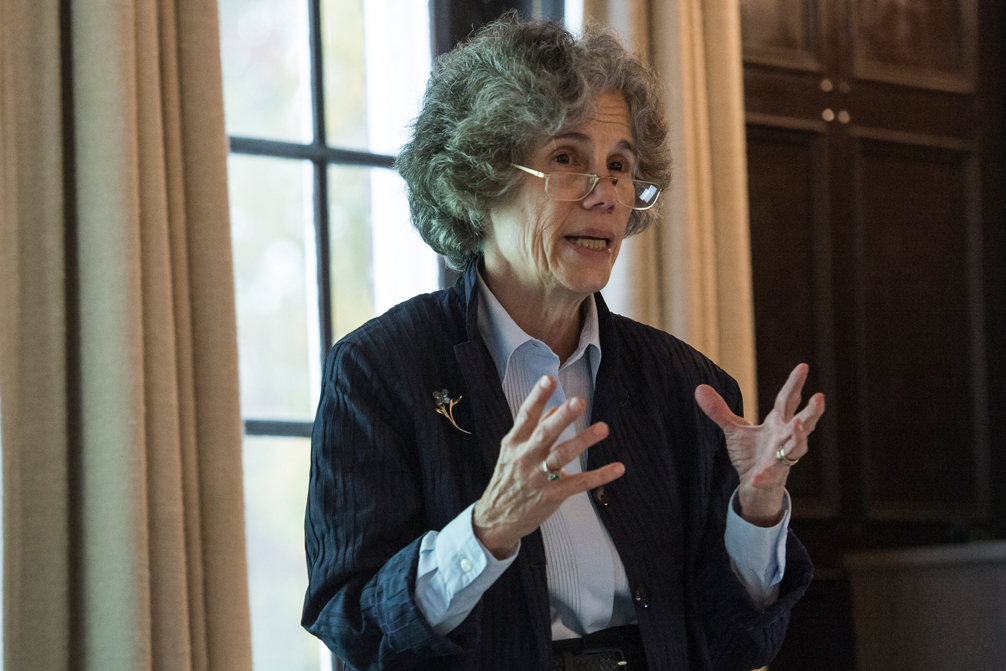Prison isn’t exactly the type of place most of us like to think about every day. Let alone solitary confinement—the practice of putting prisoners in a small windowless concrete room with no human contact for 23 hours a day, every day, indefinitely. However, Professor Judith Resnik in a recent talk as part of Boston College’s Clough Distinguished Lectures in Jurisprudence series, challenged us to stop and think about exactly that, to take a step away from our comfortable lives and think about the 80,000–100,000 prisoners in the United States who are currently in solitary confinement.
While Resnik, the Arthur Liman Professor of Law at Yale Law School, has written and spoken about numerous areas of the law, she has recently turned her attention to the problem of prisons and punishment. In her talk, “Not Isolating Isolation: Whippings, Solitary Confinement, Prisoner Disenfranchisement, and the Bounding of Licit Punishment,” she examined the question of what the relationship is between the conditions of confinement in prison and punishment itself.
She began with a walk through the history of prisons and punishment, from the litigation over prisoner’s rights in southern plantation prisons to the Attica uprising in New York in the 1970s to modern day prisons and solitary confinement. The common thread throughout this history, she said, was that the courts saw prisons are an implementation for punishment and not as punishment itself. As such, the law’s role was to regulate the type of punishment that prisons enforced.
Part of Resnik’s interest in the area stemmed from what she has labeled one of the “worst Supreme Court decisions,” Wilkinson v. Austin. In Wilkinson, Justice Anthony Kennedy wrote an opinion for the Court that seemingly endorsed the use of solitary confinement in the prison context. In that decision, the Court held that a prisoner’s private liberty interest in not being held in solitary confinement must be viewed in light of the fact that they were already in prison. In other words, the Court had started from the fact that the prisoner’s liberty was already curtailed by virtue of imprisonment and then reasoned that solitary confinement, in comparison to prison in general, was not such a great leap as it would be for a non-incarcerated person.
The problem with this logic, Resnik argued, was that prisons shouldn’t be the norm or starting point in considering a person’s liberty. Instead, prisons should themselves be looked at as a type of punishment.
She turned towards Europe as an example where this type of thought was taking place. The European Court of Human Rights had recently ruled that since prisoners are people, the burden must be on the state to justify taking away some liberty. In other words, we shouldn’t be looking at prisons as typical and then seeing what is atypical compared to that, but the other way around. Under this theory, our view of prisons as vehicles for the administration of punishment would change instead to viewing prisons as a type of punishment themselves.
While the Wilkinson decision was disheartening to many in the prison reform scholarship, Resnik concluded her lecture with some hope for the future. She had argued that much of the change in prison reform over the last 60 years had come through not just legal changes, but also social and cultural ones.
It seems that the same is happening today: Congress has recently proposed legislation to limit what solitary confinement may entail and President Obama has also turned his attention to the issue.
Another convert? Justice Kennedy, the one who wrote the “terrible” 2005 Wilkinson opinion that legalized solitary confinement, Resnik said. He recently commented in a concurring opinion in a 2015 case (Davis v. Ayala) that maybe the Court might need to take a second look at the constitutionality of solitary confinement.
Story by Josh Moore ’17
Photograph by Greg Bodine, MTS, BC


